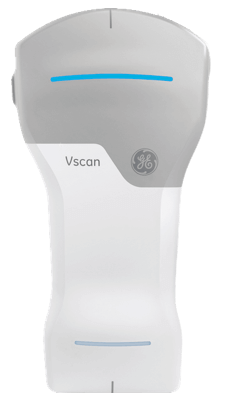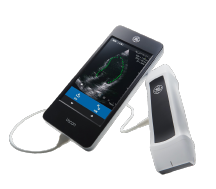
Handheld ultrasound may present the opportunity to help physicians further engage their patients, which is why some are evaluating adding it to their practices. After all, having another diagnostic tool is appealing to providers looking to improve patient care. However, bringing in this new technology requires training to get the most out of it.
Many technologies have been presented as solutions, but few offer the accessibility, results and efficiency of hand-held ultrasound. For example, a study in Clinical Cardiology demonstrated “that the pocket-sized [portable transthoracic echocardiography (pTTE)] provides accurate detection of cardiac structural and functional abnormalities beyond the [electrocardiogram].” It also found that “the use of pTTE as an initial screening tool prior to [standard TTE] is cost-effective.” And yet, the benefits don’t stop there.
An Exceptional Patient Experience
The majority of patients most likely appreciate fewer tests, more convenience and reduced complications in their billing and financial experiences. Reducing unnecessary tests is important, and point of care ultrasound may be a practical step toward achieving that goal. According to Heart, “[Hand-held cardiac ultrasound] performed at the point of care by [family doctors] with remote expert support interpretation using a web-based system is feasible, rapid and useful for detecting significant echocardiographic abnormalities and reducing the number of unnecessary echocardiographic studies.”
Increased Physician Engagement
Put simply, becoming a more confident user of handheld ultrasound gives physicians another way to engage their patients. According to the Journal of Ultrasound in Medicine, “By implementing pocket-size ultrasound examinations that took less than 11 minutes to the usual care, we corrected, verified or added important diagnoses in more than 1 of 3 emergency medical admissions. Point-of-care examinations with a pocket-size imaging device increased medical residents’ diagnostic accuracy and capability.”
Empowerment Through Ultrasound Training
Giving physicians access to the benefits of these new approaches to ultrasound and the physical examination requires training that is adaptable and that empowers physicians to optimize their results and maintain their skills over time.
On-Demand Training
The benefits of portable ultrasound training shouldn’t be limited just to residents. Physicians who are advanced in their careers need flexible training methods to maintain and refresh their ultrasound skills over time.
Comprehensive, on-demand options facilitate continuous education and are accessible to physicians ranging from novice users who are just learning the technology to experienced practitioners who want to keep their skills sharp. These options include the following:
- Focused courses.
- Online videos and tutorials.
- Point-of-care technology courses.
- Point-of-care preceptorship courses.
- Third-party training options.
- Coaches.
- Webcasts and webinars.
Learning Online
Online training now offers flexibility and continuous education that wasn’t possible in the past. GE’s POCUS FocusClass by 123 Sonography may help doctors gain confidence in performing basic ultrasound studies and interpretation. Physicians have access to modular options that can be tailored to training budgets, schedules and learning styles. These include common applications involving the following:
- Heart.
- Lung.
- Obstetrics.
- Kidney.
- Vascular (abdominal aorta and deep vein thrombosis).
- Biliary tract.
This type of training is designed specifically for primary care physicians and their busy schedules so that proficiency can be developed with maximum efficiency.
Today’s ultrasound training options offer a wide range of benefits, including providing opportunities for physician champion projects, patient interaction initiatives and overall engagement goals. Clinical leaders invested in keeping their teams up to date in a fast-changing clinical technology landscape should keep ultrasound training on their shortlist of priorities.




